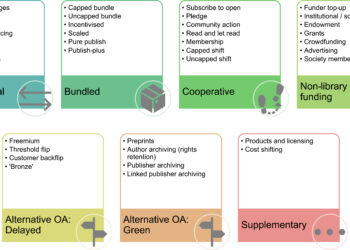
The long-awaited and much-anticipated White House Office of Science and Technology Policy (OSTP) guidelines for “Expanding Public Access to the Results of Federally Funded Research” were released last Friday. The policy has been met with appreciation and approval from a wide range of stakeholders, ranging from open access (OA) advocates to publishers. This is a fair and sustainable policy that offers much to the public good.
The policy has a lengthy history. It was an early priority for the Obama administration and they performed a round of public consultation to inform their policy in 2009. Congress added process requirements with the America COMPETES Act Reauthorization of 2010, which included a second round of public consultation, done in 2011.
A recent “We The People” petition was a key factor in raising the profile and driving approval of this policy for the administration. The petition, led by a team of advocates, an academic, and a leading publisher, is a great example of how powerful collaboration can be. It is a sign of the maturation of OA as a social movement — a shift from angry confrontation and rhetoric to seeking common ground and working toward effective, real-world change.
The policy focuses on two distinct areas — access to the papers published as a result of federally funded research, and access to the data produced by such projects. Guidelines are presented, and each US science funding agency with “over $100 million in annual conduct of research and development expenditures” is required to develop a plan within the next six months.
To my knowledge, the agencies covered are the following: NIH, CDC, FDA, ARHQ, NSF, NASA, DOE, USDA, FAA, FHWA, NIST, NOAA, USGS, EPA, DOD, VA, USAID, Dept. of Education, and the Smithsonian (please chime in below if I missed any).
It’s impossible to know yet how each agency will set policy, but there are some fairly clear messages being sent. It is evident that the OSTP has their priorities in the right place and recognizes that access to and reuse of the data generated by federally funded research is of greater importance than reuse of published papers. Textmining applied to the reports written about research may indeed have potential, but that potential likely pales in comparison to developments coming from the actual results of the research.
Data access and reuse, however, are limited by intellectual property (IP) law, particularly the Bayh-Dole Act. The data guidelines specifically note that any policy must recognize IP rights and avoid any negative impact on them. As such, any requirements may be essentially toothless, if researchers decide to exercise their IP rights and patent their results. Really, this is more a question for the researchers themselves to answer — whether they’re willing to sacrifice personal and institutional gain in favor of more rapid progress.
Leaving aside the implications for data access and reuse, here are some first impressions on the guidelines for public access to funded research papers (as always, with the caveat that I am neither a lawyer nor a legislator):
Not science only. The policy deliberately does not limit its impact to science research. Any research funded by any of the agencies that meet the budget standards will be covered.
“. . . within the existing agency budget . . .” The guidelines call for agencies to develop their plans without any additional spending. This stands in stark contrast to policies like that of the RCUK which require large sums to be added per year to existing budgets. It is clearly intended to rein in any outlandish implementations that carry an unnecessary price tag. Many agencies already allow for research funds to be spent on Article Processing Charges (APC’s) for immediate Gold OA, but the decision to divert funds in this manner is meant to be left where it should be, in the hands of the individual scientists.
This means the new policies, with the explicitly stated 12-month embargo period, will most likely resemble that of the established NIH policy. Agencies will require funded papers to be made freely available after 12 months, and this will likely meet little resistance, at least from science publishers who are already compliant with the NIH requirements. One major difference, though, is that the funds to create and maintain a new PubMed Central repository for each agency don’t seem to exist (PubMed Central itself is codified by separate law and will continue to exist, however).
The journal as repository. In fact, deposit in a repository is not a requirement of these guidelines whatsoever. An agreement by publishers to provide free access to funded articles on the journal’s website after 12 months should fulfill the access requirements of this policy, assuming that the journal offers sufficient discovery and archival assurances for long-term preservation and access. As an alternative, freely accessible versions on journal websites combined with a “dark archive” would suffice.
This is much of what is meant by the calls for fostering public-private partnerships and for avoiding duplication of existing mechanisms. The benefit for the publisher here is that traffic will no longer be diverted away from the journal, which will retain its ability to drive commercial revenue through advertising sales. For the reader, access will be provided to the fully up-to-date version of record for each paper, a problem that has plagued repositories which aren’t updated with corrections or retractions.
Reuse favored, but no specific license required. The policy calls for, “maximizing the potential to create new business opportunities,” and, “creative reuse to enhance value to all stakeholders.” There is no call for any specific license, no CC-BY requirement. The lack of additional funding to pay for across the board CC-BY licensing would seem to rule this out, and that second statement including “value to all stakeholders” seems a pretty clear indication that publishers should be encouraged to license content for reuse, but should also be able to seek value from those licensing activities.
The 12-month embargo. This policy seems written to be immediately effective and to get things done, rather than to raise new controversies and spend months, if not years, delayed by repeated hearings and lawsuits. The 12-month embargo period is emblematic of this. There is a great deal of evidence from the NIH policy that 12 months does not threaten the subscription business model for life science and medical journals. I’ve yet to see any evidence of subscription cancellations based on a library choosing to wait a year to access the latest scientific research (and remember, the diversion of traffic from the journal to a repository is not a concern with this policy).
Embargo periods should be rational and evidence-based. A mechanism is provided for changing the embargo period, lengthening or shortening it, but this requires the presentation of evidence for why that change is necessary. This adds potential for customized policies for different fields of research, avoiding the “one size fits all” problems of less flexible proposals.
Ripple effects. The establishment of these policies will reach beyond the executive branch of US government and beyond the US itself. It’s unclear now if there’s any life left in legislation like FASTR. Will Congress be willing to pass a law overwriting a policy they asked the White House to develop? After requiring interagency and public consultation in America COMPETES, why would they then skip these steps and implement FASTR? Will they bother expending time and effort on a law where measures are already in place to alleviate the issue in question, and would they do so before those measures can actually be implemented and their results known?
Major questions also arise for policies like that of the RCUK. The RCUK is already being taken to task by the UK government for its lack of clarity and unclear potential results. The RCUK policy calls for extensive additional spending to make funded articles immediately available through paying APCs for Gold OA. This funding was meant to set a worldwide standard, with the assumption that as other countries did the same, the UK would eventually receive more back in return than it spends.
Now the UK is stuck with an expensive policy that so far Australia and America have chosen not to match. Will the UK continue to try to drive worldwide policy in this manner, or, given the already tenuous state of their policy, choose instead the less expensive path already in place for other nations?
The importance of FundRef. The individual agencies have had access to this policy for a while now, and are already making progress on implementation. The one major worry is the potential complexity that may result if each agency implements a wildly different set of regulations as a result. This may cause confusion for both authors and publishers in meeting the needs of those authors.
Agencies are urged to work together to avoid this unnecessary complexity and there may be great benefits beyond the obvious cost savings from doing so. Science is increasingly entering into an interdisciplinary era. Siloed discovery tools like PubMed will hopefully give way to broader, science-wide resources that better suit the research of the future.
But the proof will be in the pudding, and concerns here make it clear why FundRef is such an important project to be sure we have an automated way to discern a paper’s funding source and apply the appropriate conditions.
More to come . . . This set of first impressions should by no means taken as definitive. Actual implementation will have to be monitored, but the strong emphasis on cooperative interactions by all stakeholders bodes well.
This fair and even-handed policy should be seen as a major victory for both OA advocates and for publishers. Our core mission — getting vital information into the hands of as many as possible — is enhanced by this policy. That it allows us to achieve this without threatening the sustainability of the important services we provide to the research community must be seen as a win for all.
Discussion
15 Thoughts on "Expanding Public Access to the Results of Federally Funded Research: First Impressions on the US Government's Policy"
Thanks David, very nice summary.
Your insistence that a 12 month embargo is not harmful is completely wrong for many fields. Most biomedical journals already had content open after 12 months but this is most certainly NOT the case in all disciplines likely to be affected by this kind of mandate. As I noted on the previous post, the engineering field is slower to rely on new research and the backfile is more valuable than the newer content in many areas.
I tried to specifically limit my “insistence” to the areas where the experiment had actually been done, life sciences and medical journals. If I missed clarifying this at any point, I apologize.
The policy seems designed though, to address your concerns. The next steps would be to identify the funding agencies behind the papers in your journals and to work with them in establishing an appropriate embargo period. Evidence that you can present showing the different life cycle of papers in your field will be key.
David, I’m a little nervous on the interpretation on what “evidence” would constitute sufficient rationale for changing a policy:
Further, each agency plan shall:
ii) shall also provide a mechanism for stakeholders to petition for changing the embargo period for a specific field by presenting evidence demonstrating that the plan would be inconsistent with the objectives articulated in this memorandum
Does a publisher need to provide overwhelming evidence that public access results in subscription decline? If so, this is going to be difficult. For a librarian, the decision to cancel a publication is based on more than just access policy and involves many factors including publisher-provided usage data, faculty input, among others. And even if such evidence were available, by the time a federal policy was changed, the damage would have already been done.
“The benefit for the publisher here is that traffic will no longer be diverted away from the journal, which will retain its ability to drive commercial revenue through advertising sales.” WHAT advertising sales? This isn’t the world my journal is in. We need subscriptions or we need open access processing fees or we’re out of business. There’s no magic.
PLoS and other OA journals do a good job of selling advertising. Clinical journals are migrating, as Carol mentions above, although the decline in print ad sales is making online ad sales comparable in an uncomfortable way. There is a business here, but it’s not as big or reliable for many as subscriptions or APCs.
Rachel, traffic is important in many ways beyond ad sales (though for some journals, ad sales are enormously important revenue streams). Traffic is how librarians make their decisions for whether to subscribe to your journal. Traffic reinforces your brand and the value you present to readers. Traffic allows your readers to discover other papers in your journals and other features you offer to readers.
If the system is instead set up to divert traffic away from your journal, to a different version of the article hosted by someone else in a repository, that takes away traffic from you, and is a bad thing for your business. A system where the version of record in the journal is the one that readers go to is vastly preferable.
But to speak to your larger point, this is the world in which we live. Things are changing, and we need to adapt to better serve our customers. Funder mandates are a part of the landscape and aren’t going away.
Our readers and authors are dependent on the funding they receive in order to do their research and to earn a living. If that funding is now dependent on publishing their papers in a particular manner, then that is exactly what they are going to do. Scholarly publishing is a service industry, and it is our job to find a way to provide the services that the scholarly community needs. If we don’t do this, someone else will take our place, for better or for worse.
Just as we adapted our models when moving from a print-only world to a predominantly online world, we can and will adapt here. If your field cannot sustain a 12 month embargo, this policy offers opportunity to change that embargo length. You may not find any embargo length that works, and yet there are still alternatives such as moving to a fully OA model where all authors are charged and APC for immediate OA, or a partial one where US govt. funded authors pay a fee for delayed OA. You may though, be competing against journals that offer this for free. Alternatively, you may just lose some subscribers and may have to raise rates on your remaining subscribers or find alternative revenue streams.
That’s how business works in a disruptive period. No one is guaranteed to survive, but that’s not all that different from any other era. I’m confident that as an industry, we’ll find ways to meet our customers’ needs and continue to offer them the superb level of service and expertise they need. This policy makes that a lot easier than many of the others I’ve seen proposed and/or implemented.
Interesting summary, David thanks.
At the SSP Librarian Focus group (http://www.sspnet.org/events/librarian-focus-groups/) earlier this month, the panel of librarians was specifically asked if cancellation decisions were based in whole or in part on the open availability of back content for a journal. The answer varied: for large research institutions like Harvard, current life sciences subscriptions were considered essential. Other institutions do factor open availability into their cancellation decisions: they felt they could wait for the embargo period and supplement with interlibrary loan or document delivery servies. Of course, this report is anecdotal, but the practice bears watching.
Rachel has a good point as well. Advertising revenues are probably highest in clinical journals, but as far as I know online advertising revenue has not begun to approach print revenue, which itself is declining dramatically. Many scholarly journals have no advertising revenue at all and no community of suppliers to advertise.
FundRef is indeed important but it is just a pilot project at this point so no agency can design their OA system based solely on it. FundRef needs to be fielded as quickly as possible. The 6 month agency design clock has started.
There is a wild card in this game that I have not seen mentioned, namely the lately proposed Research Works Act banning green OA at federal science agencies. RWA appears to have been a message from House Republicans, who for now fund the agencies. There is a growing tension between the President and the House over Executive actions that bypass Congress. The OSTP action may fit this description as it in effect regulates the scholarly publishing industry without legislative authority. For the moment everyone is busy going over the fiscal cliff but do not be surprised if we get some push back from Congress in the fullness of time.
Reblogged this on scipolicyeu and commented:
#openaccess funded research



